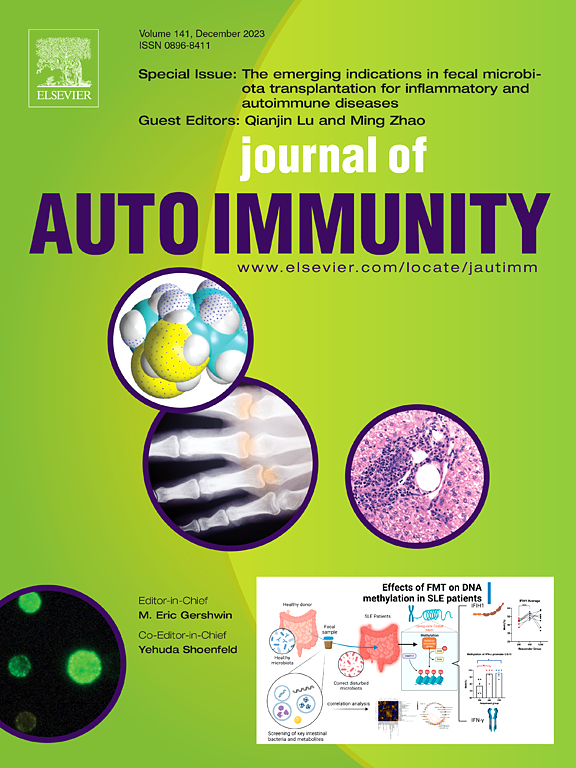干扰素信号促进系统性红斑狼疮患者B细胞过度活跃和浆母细胞扩张
IF 7
1区 医学
Q1 IMMUNOLOGY
引用次数: 0
摘要
系统性红斑狼疮(SLE)是一种自身免疫性疾病,其特征是一系列自身抗体,特别是抗核抗体(ANA)。本病还以浆母细胞(PB)扩增和高γ -球蛋白血症为特征。这种过度活跃的机制及其与自身抗体产生的关系尚不清楚。我们的目的是表征SLE中的B细胞过度活跃,以确定其潜在机制。利用流式细胞术和scRNAseq的深度表型分析,我们证明了相对于记忆B细胞的高频率PB标志着SLE患者的一个亚组,特别是那些疾病活动性较高且Sm/RNP自身抗体阳性的患者。我们发现这种表型的起源是在PB中显著的IFN特征和CD27+记忆B细胞区室中激活增加。来自这组SLE患者的PB显示出高水平的CD45RB和体细胞高突变频率,类似于记忆B细胞。曲目分析显示PB高度多克隆扩增,并向IgG1倾斜。B细胞过度活跃与高丙种球蛋白血症相关,尤其是血清IgG水平升高。总之,我们首次在SLE患者亚组中发现IFN与PB扩张之间的直接关系。由IFN驱动的类别转换B细胞的激活和分化增加可能是PB扩张和高γ -球蛋白血症的直接基础。这些结果提供了对导致B细胞过度活跃和自身抗体产生的途径的深入了解,这可能指导B细胞和ifn靶向治疗的定制。本文章由计算机程序翻译,如有差异,请以英文原文为准。

Interferon signatures fuel B cell hyperactivity and plasmablast expansion in systemic lupus erythematosus
Systemic Lupus Erythematosus (SLE) is an autoimmune disease characterized by an array of autoantibodies, in particular anti-nuclear antibodies (ANA). The disease is also hallmarked by an expansion of plasmablasts (PB) and hypergammaglobulinemia. The mechanisms underlying this hyperactivity and its relation to autoantibody production is not clear. We aimed to characterize B cell hyperactivity in SLE to identify its underlying mechanisms.
Using deep phenotyping with spectral flow cytometry and scRNAseq, we demonstrate that a high frequency of PB relative to memory B cells marks a subgroup of SLE patients, particularly those with higher disease activity and positive for Sm/RNP autoantibodies. We identified the origin of this phenotype in a prominent IFN signature in PB and increased activation in the switched CD27+ memory B cell compartment. PB from this group of SLE patients displayed high levels of CD45RB and somatic hypermutation frequencies similar to memory B cells. Repertoire analysis revealed a highly polyclonal expansion of PB and skewing towards IgG1. B cell hyperactivity correlated with hypergammaglobulinemia, especially increased IgG serum levels.
In summary, we show for the first time a direct relationship between IFN and PB expansion in a subgroup of SLE patients. Increased activation and differentiation of class-switched B cells driven by IFN may directly underlie PB expansion and hypergammaglobulinemia. These results provide insight into the pathways leading to B cell hyperactivity and autoantibody production which may guide the tailoring of B cell- and IFN-targeted therapies.
求助全文
通过发布文献求助,成功后即可免费获取论文全文。
去求助
来源期刊

Journal of autoimmunity
医学-免疫学
CiteScore
27.90
自引率
1.60%
发文量
117
审稿时长
17 days
期刊介绍:
The Journal of Autoimmunity serves as the primary publication for research on various facets of autoimmunity. These include topics such as the mechanism of self-recognition, regulation of autoimmune responses, experimental autoimmune diseases, diagnostic tests for autoantibodies, as well as the epidemiology, pathophysiology, and treatment of autoimmune diseases. While the journal covers a wide range of subjects, it emphasizes papers exploring the genetic, molecular biology, and cellular aspects of the field.
The Journal of Translational Autoimmunity, on the other hand, is a subsidiary journal of the Journal of Autoimmunity. It focuses specifically on translating scientific discoveries in autoimmunity into clinical applications and practical solutions. By highlighting research that bridges the gap between basic science and clinical practice, the Journal of Translational Autoimmunity aims to advance the understanding and treatment of autoimmune diseases.
 求助内容:
求助内容: 应助结果提醒方式:
应助结果提醒方式:


